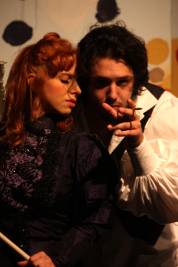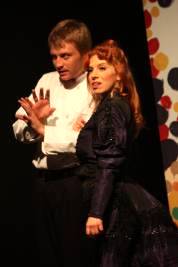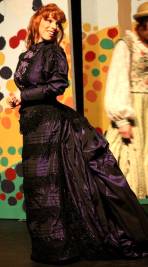
If it’s true that money can’t buy happiness or love, then it’s also true that money can’t guarantee a successful theatrical endeavor, the best example being the money pit that Spider Man: Turn Off The Dark has turned into. $65 million as of last count, which was back in November, so goodness (or in this case badness) only knows how much its cost has risen to as of March 2011. By the same token, terrific theater can be made for a pittance, as proven by Still Hungry Theater’s on-a-shoestring intimate revival of Stephen Sondheim and James Lapine’s Sunday At The Park With George.
Despite a constricting blackbox space and other budget and design shortcomings, Still Hungry’s Sunday succeeds, and quite well indeed, thanks to its talented cast and a trio of fine musicians led by a top-notch musical director.
Inspired by the brief life of French post-Impressionist painter Georges Seurat (1859-1891), Sunday In The Park With George divides itself into two distinctly different, yet related, acts. The first, taking place in 1884, gives us several days in The Life Of A Young Artist, as he struggles with his art and his personal life. Specifically, there is his conflicted relationship with his girlfriend-model Dot, a fictional character wittily named after the dots of color that define his pointillist style of painting. Act Two, set in 1984, gives us Dot’s great-grandson George, a contemporary artist dealing with his own struggles to find inspiration and create art, and modern George’s 98-year-old grandmother, Dot’s daughter Marie.
Coming not long after 1980’s Merrily We Roll Along flopped on Broadway, Sunday In The Park With George revitalized Stephen Sondheim’s career, gave Mandy Patinkin and Bernadette Peters arguably their greatest roles to date, and introduced the world to the songs “Putting It Together” and “Sunday,” the latter of which Jonathan Larson satirized brilliantly in Tick, Tick… Boom!
Still Hungry Theater is Trojan grad Keith Barletta’s baby, and he is quite appropriately Sunday In The Park With George’s producer and star, having appeared in a supporting role in USC Musical Theatre Repertory’s production of the same show just over three years ago—an intimate staging that showcased the brilliantly imaginative direction and set designs of then-student Steve Edlund.
If Nicole Rossi’s direction is decidedly more workmanlike, it is nonetheless competent work, the director aided considerably by a cast which includes a number of current BFA students and recent grads, all of them up-and-comers.
A dynamic Barletta creates an effective portrait of a troubled young painter obsessed with his art to the detriment of his human relationships, refreshingly different from Patinkin’s performance, with particularly strong vocal renditions of “Finishing The Hat” and the canine anthem “The Day Off.” At the same time, both Georges’ spoken scenes could benefit from upping volume and projection.
Kristin Towers-Rowles is luminous as Dot and Marie, so startling different from her just-completed roles as Lilli and Katherina in Kiss Me Kate that it seems scarcely possible the parts have been played by the same actress. Act One’s Towers-Rowles is heartbreakingly transparent as George’s lover-victim-survivor, Act Two’s Marie a deeply affecting mix of Southern grit and geriatric frailty. Towers-Rowles’ soprano is crystal clear, her stage presence magnetic, her acting rich and moving, and she never once recycles Bernadette.
Lapine’s book gives each supporting player a chance to strut his or her stuff. Cindy Bullock makes a pair of strong impressions—in Act One as George’s mother, her duet with Barletta of “Beautiful” quite beautifully performed by both, and as Act Two’s glamorous art critic Blair. Kelsey Bullock and Katie Hughes are a delightfully feuding pair of best friends named Celeste, and a handsome, amusing Peter Fuller (and his cardboard doppelganger) is the object of their affection. Matthew Artson and Aileen-Marie Scott do fine work as the snooty self-described art connoisseurs Jules and Yvonne, Romy Cutler-Lengyel and Frank Weidner make for the very funny German pair of Frieda and Franz, with Matthew Modine lookalike Weidner an Act Two standout as modern George’s best bud Dennis. Joe Massingill does terrific work as a rough, limping, eye-patched French boatman. Anna Rubley is quite lovely as 19th Century George’s mother’s nurse, doubling to humorous effect as the stereotypical American tourist wife of stereotypical American tourist Nick Rogers (who also doubles winningly as Dot’s savior, Louis the Baker). Jessica Stone creates a pair of night-and-day different characters—Jules and Yvonne’s obnoxious child Louise and brassy 20th century composer Naomi Eisen.
Taking the place of a full Broadway orchestra—and quite nicely indeed—are Karen Waddill on keyboard, Kevin Schwarzwald on violin, and Jessica Neilson on clarinet, the trio under the impeccable baton of musical director Andrew Zackary. Occasionally, though, their amped volume somewhat overpowers the unmiked vocalists.
Thankfully this is not the case when the entire ensemble joins voices, as for the exquisite Act One finale “Sunday”, the witty Act Two opener “It’s Hot Up Here,” and the production’s closing number, an exquisite “Sunday” reprise. All that’s missing in the ensemble is a greater age variation than the early-twenties the majority of them are.
Still Hungry Theater has done the best possible job on an obviously tight budget, but most of its design elements can’t compete with other intimate stagings this reviewer has seen. Cindy Bullock’s costumes are the production’s strongest design, especially her gorgeous late-19th Century creations. Kelsey Bullock’s bare-bones five-panel scenic design (one side of each white, the other side colorfully painted pointillist style) rotates a bit awkwardly but in ingenious configurations, nicely lit by lighting designer Erin Anderson. Performer Scott doubles as properties designer. Megan White is stage manager.
Whatever shortcomings this Sunday In The Park With George may have in design, it makes up for in talent, enthusiasm, and commitment to art. With vocal and instrumental performances as strong as those assembled by Still Hungry Theater, any minuses are largely forgotten by the time the final, exquisite note has been sung.
Ruby Theater in The Complex, 6476 Santa Monica Blvd., Hollywood.
www.stillhungrytheater.com
–Steven Stanley
March 4, 2011





 Since 2007, Steven Stanley's StageSceneLA.com has spotlighted the best in Southern California theater via reviews, interviews, and its annual StageSceneLA Scenies.
Since 2007, Steven Stanley's StageSceneLA.com has spotlighted the best in Southern California theater via reviews, interviews, and its annual StageSceneLA Scenies.







 COPYRIGHT 2024 STEVEN STANLEY :: DESIGN BY
COPYRIGHT 2024 STEVEN STANLEY :: DESIGN BY